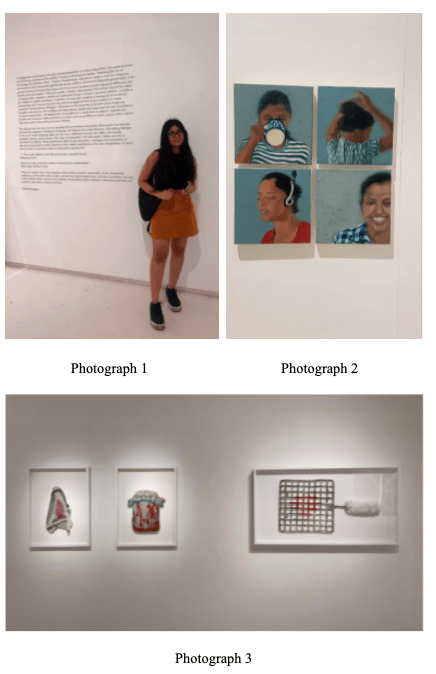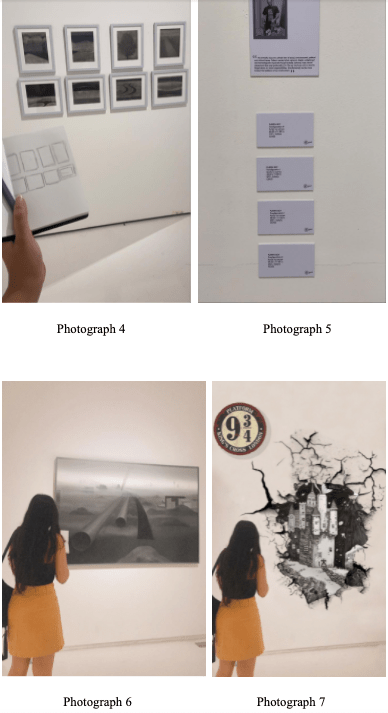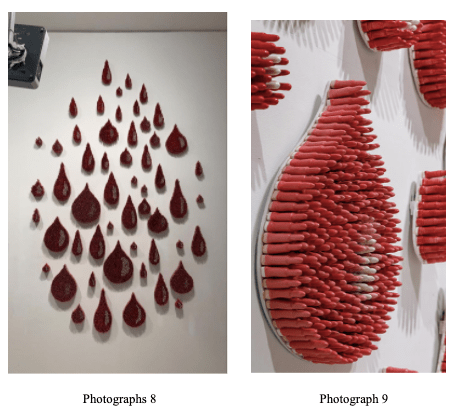Art Markets Final Project
by Aanya Gupta
Initially I was unsure whether I would be able to go and personally visit an art space due to the ongoing pandemic since my city, Kolkata, still has restrictions imposed to regulate the high number of Covid-19 cases. All art museums are supposed to be closed until the 31st of July but after a lot of research I found a gallery space open for visits, an hour from where I live. The exhibition was called Sublime Transferences, curated by Nanak Ganguly at the Kolkata Centre for Creativity. The intention behind the exhibition was to give expression to and stimulate a greater awareness towards visual phenomena that still exist often concerning space to play the paradox of permanence and transience. It engaged with contemporary art, creating a room for imaginary conversations and unexpected togetherness across artists of diverse and disparate styles in the present moment of transit where space and time cross to produce complex figures of difference and identity, past and present, inside and outside, inclusion and exclusion that centres around the notion of displacement, migration, identity and particularly living in a reality in the midst of a global pandemic. (Photograph 1)
The works displayed ranged from a 3D installation made entirely of ceramics to etchings of various landscapes made on wood. The attempt had been to bend the conventions of practices, blurring the line between self and the imaginary, infusing art language with literary and visual allusions, and calling attention to the art of visual language itself, not with cool, intellectual remove, but rather with wonder, gratitude, daring, and sly humor. All the walls of the gallery were white, creating a kind of void so the viewer’s attention was only drawn to the work and not any other superfluous distraction, with lights which were not too harsh either. The installations, canvas paintings and wood art were all adequately spaced from one another, with less gaps between one continuous body of work as compared to the gaps between the works of different artists (Photographs 2-5). There were small wooden benches in the centre of the gallery and a table with packaged water too. The entire exhibition was extremely well thought out, with staff present at an information desk nearby in case of any confusion or direction required. Moreover, on the left of the body of work was the artist’s name, size of the work, medium and the curatorial rationale was mentioned. However, these works were not for sale, only for viewing purposes. This indicated that the mission of the gallery was to increase the representation of local artists and help them build recognition and status, instead of just wanting to commercialise and profit off of their art. The only aspect they could have improved upon would be the music since there was none. Perhaps the presence of a soft, classical tune would add a lot to the overall experience of the gallery. Since Kolkata still has lots of restrictions for leaving the house, there were very few people at the gallery when I visited so it was quite peaceful and gave me room to think, analyse and make connections with the works. (Photograph 6) I felt extremely comfortable, excited, and happy to be completely surrounded by art, not only by different artists, but also having different intentions, backstories and experiences – it made me think of perhaps how Harry felt when he visited Hogwarts – I felt like I belonged. (in fact I even made an edit in the Photoshop class of the course to represent this feeling, with one of my pen and ink illustrations of a castle – Photograph 7)
The diversity of the pieces and the artist’s intents reminded me of an insightful discussion I had while discussing Visual Arts as an Area of Knowledge, where we discussed how artists, consciously or subconsciously, tend to make art based on their life and as responses to pressing cultural and historical needs of the time during which they live, leading them down the journey of discovery, learning and exploration. The works I viewed revealed themselves as tropes of awareness, accelerating the assimilation of what environmental experiences have to offer in concentrated form. The success of interdisciplinary dialogues between all the pieces and the moving act of emotional archaeology and memory was palpable, showing the enormous depth of work across the different media.
Having visited the gallery with two of my friends, what struck me the most was the versatility of our interpretations of the same works. It made me aware of how every viewer has a different perception of a piece which is influenced by their prior knowledge, visual perception of the work as well as their previous experiences. I then compared our interpretations with the artist’s original intent and objective which agreed with what I had stated earlier – all the artworks had visual links to things beyond the artist’s personal experiences are outward looking and connect the work into a wider culture, ideas, politics of other artists and thinkers, making the work more understandable to others who are unable to piece together the visual links and clues provided in the piece, to gain a deeper understanding of what the piece is truly about. This led me to the revelation that while art has the ability to stand on its own, with little need for explanation, a piece can often prove to be more impactful when the story behind it is understood. While forming one’s own views on a piece is important, the artist’s true intention can only be conveyed through conversation or write-up. While the subliminal intention of the artist is conveyed through the nature of the piece itself, context is necessary to completely understand and experience it.
My favourite piece was an installation made by Gargee Ghosh, titled Feminine Flow – II, made entirely in ceramic, consisting of numerous lipstick cases that she herself created (Photographs 8-9). Each piece had been baked in a kiln and arranged to represent a repressed femininity and abjectivity. The lipstick cases were semiotic markers representing the artist’s feminine position. The position of women was represented as being exploited, repressed and subject to inequalities – that of a second sex and subservient status in our socities despite the modernism we repeatedly talk about; as if women were tools in a continuous flow of production. The inequality of gender, sexual exploitation and female body as a subject of male gaze has remained central to her work.
When I first viewed the work however, the visual representation of it hinted at femininity and the choice of colours as well as the teardrop shape led me down the train of thought of the taboo associated with menstruation. In Indian society, people still don’t like discussing this topic and women still aren’t allowed to enter the kitchen or places of worship while menstruating because it’s considered ‘impure’. It also made me think about the hardships that women face and the discrimination faced by women as a manifestation of a patriarchal mindset. In the world of beauty, a lot of contradictions are prevalent, the biggest of which is related to makeup – women are either labelled as wearing ‘too much’ makeup, which is admonished as flashy, insecure or trying too hard, or women who don’t wear makeup are lectured about daring to be ‘ugly’ in public, not trying enough, looking tired or sick and in general offending the world with their plain visage. I thought the usage of lipstick cases was symbolic of this dilemma faced by women due to these double-standards.
The gorgeous artworks that I viewed during my visit induced a feeling of inferiority about my artwork, but also made me realize that I shouldn’t be comparing my work with those of professionals. I realised that when we learn a new skill, we get exposed to a lot of good work and develop a good taste, but our taste develops much faster than our skill. Comparing myself with the experts in that field would get me nowhere, but comparing my work to what it was the day/week/month before would help me improve – judging my own work in a harsh way would only demotivate me – the exact opposite of what I hoped this visit would do. Moreover, it proved that creativity isn’t stumped even amidst situations as dire as the one we faced – it finds ways to grow and nurture itself and acted as a motivator for me to continue to practice and improve on my artworks.
Visual References


